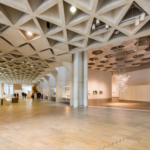
The Essential Guide to a Day at the NGA
The National Gallery of Australia (NGA) is the national art museum for Australia, and it's also one of the biggest art museums in the country. Featuring an impressive range of exhibitions, tours, and facilities, it's a destination in itself and you'll want to make a day to explore its offerings. Here, we've listed everything you need to know for planning a day at the NGA in one handy guide.
Where is the NGA?
The NGA is located at Parkes Place, Parkes, in Canberra.
Getting to the NGA
The NGA is right in the heart of Canberra, next door to the National Portrait Gallery, and accessible by car. The NGA's main parking area is underground and accessible through King Edward Terrace off Parkes Place. Its above-ground car park is accessible off Bowen Drive. Bike racks are available if you're biking in, and the closest ACTION bus stop is a short walk away on King Edward Terrace and Parkes Place East.
How to spend a day at the NGA
The NGA has numerous tours, exhibitions, and facilities to explore, so it helps if you plan your day in advance. Check out these ideas as you plan your day at the gallery.
Morning
The NGA runs its NGA highlights tours at 10.30am, 11.30am, 12.30pm, 1.30pm and 2.30pm. These tours are free and you don't need to book. While afternoon sessions are available, visitors might enjoy starting their day at the NGA with a guided tour so they have a foundation for the rest of their visit. Note the NGA has other special tours like its Indigenous culture tours, but these are typically ticketed and for larger groups only.
Once you've done a guided tour, you can take your time exploring the different collections in depth. The huge Australian art collection includes themes like impressionism, art deco, and photography. The stunning Asian art collection includes sub-collections like Southeast Asia, Trade Textiles, and East Asia. The NGA is also home to an extensive European and American art collection, as well as a Pacific arts collection.
Afternoon
Once you've done a tour and taken your time to explore different collections in depth, you'll probably be ready for some refreshments or lunch. The NGA Cafe overlooks the Sculpture Garden and offers kids meals as well as wines by the glass. The Members Lounge has complimentary tea and coffee for visitors, and you can browse its selection of magazines, art books, and newspapers as you take a break. Alternatively, the Street Café is another option if you're looking for something to eat and drink.
After lunch, you might want to head over to the NGA's current travelling exhibitions to experience some of the temporary collections showcasing local and international artists. You could also fill up some of your afternoon with a special exhibition tour. Check what is on and make sure you book in advance if you'd like to sign up for one.
Evening
Before you leave at the 5pm closing, venture outside and check out the outdoor attractions.
The Sculpture Garden – Most of the sculptures were placed in the garden during the 1980s and they reflect the abstract, industrial aesthetic of the era. However, the famous fog sculpture by Fujiko Nakaya and the Pukamani burial poles nearby are exceptions to the rule.
The Fern Garden – The Fern Garden is located on the eastern side of the building beyond the Sculpture Garden. It's a courtyard space that's centred on the idea of landscape architecture as art and symbolises healing and rejuvenation.
The Skyspace – The Skyspace is an installation by James Turrell, and it's a viewing chamber that affects how we perceive the sky. Located on the south side of the NGA building, and it features a viewing chamber within a stupa, which is in turn surrounded by an open roof-less "pyramid" structure.
What to look for when visiting the gallery
It might be natural to feel overwhelmed or even intimidated when you're visiting an art gallery, especially a large one like the NGA with extensive collections. So where do you start and what should you look for?
First, realise it's normal to feel confused and even art professionals can be confused by certain works. Additionally, you don't have to have a deep understanding of intimidating art terms to appreciate art. Keeping an open mind could be an excellent way to approach a visit to a gallery. Often it's the unexpected things that make the most interesting discoveries and experiences.
Wall labels – Note the wall labels on artworks are designed to offer some loose threads, but the discovery is yours to make.
Be selective – Don't be afraid to be selective with your day and pick the collections, tours, themes, artists, or historical periods that interest you most.
Personalise your day – A personalised self-guided approach could be more engaging than just ticking collections off your list.
Use materials and guides – Finally, use leaflets, booklet guides, and digital options like apps and audio guides to enhance your experience.
The benefits of visiting the gallery
Visiting an art gallery like the NGA can offer a long list of benefits. For students and children, it's a community for creativity and it could help them see the value of creative work. Galleries offer programs and resources for visitors, helping you get the most out of your experience. While you can see artworks online, it can't replace the experience of appreciating a sculpture or installation in person. Finally, getting up close and personal with artworks can inspire you to be creative, thoughtful, and see the world in new ways.
After your visit to the NGA, head out to Gungahlin and check out The Marketplace Gungahlin for a range of shops and dining options.

